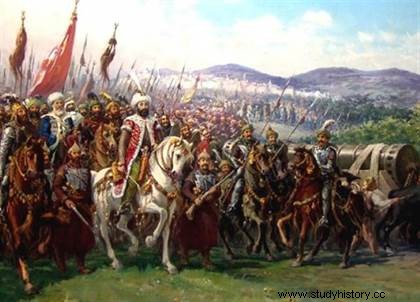 Founded in the middle of the Middle Ages, the Ottoman Empire was a Muslim state of Turkish origin which, at its height (in the 15th-16th centuries), dominated a vast territory including the entire Eastern Mediterranean and Western Asia. The founder of the Ottoman Empire was a 13th century warrior named Osman, who ruled over a small part of Anatolia. The term “Ottoman” is taken from the name of this ruler, Osman (sometimes written Othman). In 1453, under Sultan Mehmet II, the Ottomans took Constantinople and made it their own capital. The Ottoman Empire reached its peak under Sultan Suleiman I, known as the Magnificent, then gradually declined and disintegrated under the pressure of rising European powers. In 1923, Turkey was created in the aftermath of the First World War on the rubble of the Empire.
Founded in the middle of the Middle Ages, the Ottoman Empire was a Muslim state of Turkish origin which, at its height (in the 15th-16th centuries), dominated a vast territory including the entire Eastern Mediterranean and Western Asia. The founder of the Ottoman Empire was a 13th century warrior named Osman, who ruled over a small part of Anatolia. The term “Ottoman” is taken from the name of this ruler, Osman (sometimes written Othman). In 1453, under Sultan Mehmet II, the Ottomans took Constantinople and made it their own capital. The Ottoman Empire reached its peak under Sultan Suleiman I, known as the Magnificent, then gradually declined and disintegrated under the pressure of rising European powers. In 1923, Turkey was created in the aftermath of the First World War on the rubble of the Empire.
Origin of the Ottomans and first conquests
The Seljuks, descended from a clan of Oghuz Turks, left the lower reaches of the Syr Darya at the end of the 10th century. Under the leadership of Alp Arslan (1063-1073), they defeated the Byzantine army at Mantzikert in 1071. The Turkish nomads then spread to Asia Minor. Süleyman Ibn Kutulmich (1077-1006) created the Sultanate of Rum there and established his capital at Nicaea (1081). But Kiliç Arslan I (1092-1107), defeated by the crusaders at Doryliee (1097), had to retreat to Iconium (Konya). The Sultanate of Rum knows only a long agony after the Mongol invasion of 1243.
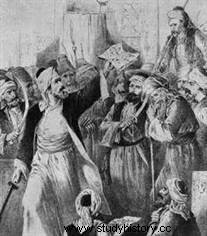 According to legend, around 1230, Ertoğrul, the leader of one of the clans of Oghuz Turks, received from the sultan Kaykobad I the border region of Söğüt (on the Sakarya River, in present-day Turkey), with the mission of protecting the Seljuks against the Byzantine Empire. Around 1280, Osman inherited the office from his father Ertoğrul. In July 1302, he defeated the Byzantines and found himself by this victory at the head of an emirate covering the north-west of Anatolia. For having created this small emirate, Osman is recognized as the first member of the dynasty of Osmanlis (or Ottomans).
According to legend, around 1230, Ertoğrul, the leader of one of the clans of Oghuz Turks, received from the sultan Kaykobad I the border region of Söğüt (on the Sakarya River, in present-day Turkey), with the mission of protecting the Seljuks against the Byzantine Empire. Around 1280, Osman inherited the office from his father Ertoğrul. In July 1302, he defeated the Byzantines and found himself by this victory at the head of an emirate covering the north-west of Anatolia. For having created this small emirate, Osman is recognized as the first member of the dynasty of Osmanlis (or Ottomans).
When Osman died around 1326, his son Ohrhan Gazi took over command of the army and extended the territory of the Ottomans beyond the Sakarya valley:capture of Bursa (today 'hui Bursa, 1326), which became the first Ottoman capital, Nicaea (Iznik, 1331) and Nicomedia (Izmit, 1337). In 1354, called by John VI Cantacuzino (usurper of the Byzantine throne), the Ottoman troops set foot on the European side of the Dardanelles strait, establishing themselves in Gallipolli (today Gelibolu).
The Ottomans masters of Asia Minor
With the reign of Murat I, who continued the policy of conquest of Ohrhan, the Ottomans became masters of almost all of Asia Minor. One year after the capture of Adrianople (Edirne, 1With Murat I (1359-1389) began the conquest of the Balkans:masters of Adrianople and Thrace, the Ottomans routed the crusade of Louis I of Hungary on the Maritsa ( 1363), symbolically affirmed their desire to remain in Europe by transferring their capital to Adrianople (1365), then undertook the conquest of Serbia.
The victory of Kossovo (June 1389) brought the Serbs, after the Bulgarians, under Ottoman rule. Bayezid I (1389-1402), while considerably expanding the Ottoman state in Anatolia (especially at the expense of the Karamanid emirs. 1391-92), completed the conquest of Serbia and Thessaly, undertook the siege of Constantinople, defeated at Nicopolis the army of Western Crusaders rushed to the aid of the Byzantines (1396). Constantinople was to be temporarily saved by the unforeseen irruption of Tamerlane into the rear of the Ottomans. Bayezid beaten and taken prisoner at Ankara (July 28, 1402), his empire nevertheless survived — for Tamerlane, after having reached Bursa, returned to Asia — but it was sacked by the invader and delivered for more than ten years to the civil wars which opposed the sons of Bayezid
Ottoman recovery began under Mehmed I (1413-1421), who consolidated his positions in Anatolia, where the Karamanids were again threatening. His successor, Mourad II (1421-1451), felt strong enough to resume the conquest. Pushed back under the walls of Constantinople (1422), he however reduced the Byzantine emperor to tribute (1424). He then seized Thessalonica, where a large part of the population was massacred (1430). In Europe frightened by the Turkish peril, fighters from all countries joined the crusade inspired by Pope Eugene IV, but the Christian army suffered a bloody defeat at Varna (November 10, 1444). Murad II was thus able to complete the submission of the Balkans, and his son, Mehmed II (1451-1481), resolved to put an end to the Byzantine Empire already reduced to Constantinople and its suburbs.
Heyday of the Ottoman Empire and reign of Suleiman
On May 29, 1453, after seven weeks of siege, Sultan Mehmet II achieved glory with the capture of Constantinople. The former Christian capital of the Byzantine Empire became, in 1458, the Muslim capital of the Ottoman Empire under the name of Istanbul (the usage, however, kept the name of Constantinople until 1923). In 1461, the last Byzantine redoubt, Trebizond (today Trabzon), fell; then Bosnia (1463), Crimea (1475) and Albania (1476-1478) came under Ottoman rule. The empire then secures mastery of the seas. In 1499, under Bayazid II (1481-1512), the Ottoman fleet won its first victory at Lepanto, triumphing over the Venetians.
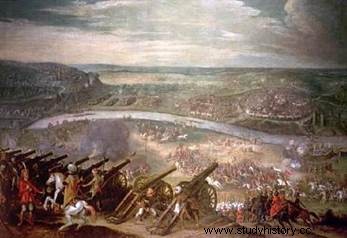 With Selim I said the Terrible, the Ottoman Empire asserts its domination over the Muslim world. Determined to unite the peoples of Islam, the sultan attacked the Shiite Safavids of Iran and annexed Kurdistan and Sunni Upper Mesopotamia. In 1516 and 1517, he fought the Mamluks, from whom he took Syria and Egypt, as well as the Hejaz. The holy city of Mecca being henceforth placed under Ottoman control, Selim proclaimed himself caliph and servant of the holy cities of Islam.
With Selim I said the Terrible, the Ottoman Empire asserts its domination over the Muslim world. Determined to unite the peoples of Islam, the sultan attacked the Shiite Safavids of Iran and annexed Kurdistan and Sunni Upper Mesopotamia. In 1516 and 1517, he fought the Mamluks, from whom he took Syria and Egypt, as well as the Hejaz. The holy city of Mecca being henceforth placed under Ottoman control, Selim proclaimed himself caliph and servant of the holy cities of Islam.
The empire reached its peak during the reign of his son, Suleiman the Magnificent — nicknamed the Lawgiver by the Turks. Belgrade was taken in 1521 and five years later, after the Ottoman victory at the Battle of Mohács (August 29, 1526), a protectorate was established in Hungary. In 1529, the Ottoman troops even advanced beyond the borders of the Habsburg Empire of Charles V, threatening the city of Vienna by besieging it. Iraq was added to the empire again in 1534, while Ottoman ships dominated the Mediterranean and the Barbary states of North Africa.
By the middle of the 16th century, Turkey had become the leading power in Europe and the Mediterranean. It included, in Asia, Anatolia, Armenia, part of Georgia and Azerbaijan, Kurdistan, Mesopotamia, Syria and Hejaz (with the holy city of Mecca, occupied in 1517); in Africa, Egypt and the “Barbaresque States” (Algiers, Tunis, Tripoli); in Europe, the whole of the Balkan Peninsula and Greece, the Danubian provinces, Transylvania, eastern Hungary and finally the Crimea. The Ottoman fleet controlled most of the Mediterranean coast and made any navigation dangerous.
Organization and administration of the Ottoman Empire
This empire, which was ruled by an absolute temporal and spiritual leader, the sultan, was one of the best administered in 16th century Europe. Turkish leaders had learned a lot from the Byzantines. The most remarkable character of the Ottoman administration was its liberalism towards the conquered countries. Alongside the provinces which constituted the Empire proper and which, governed by a hierarchy of beylerbey, sanjak-bey, sobachi, came directly under the central government (the Porte), vast territories enjoyed a more or less great autonomy:there were kings in Hungary and Transylvania, voivodes in Wallachia and Moldavia, khans in Crimea, a Sharif in Mecca, etc.
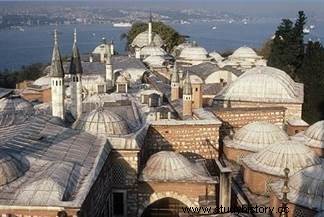 Ottoman domination left most peoples with their own language, religion and traditions, which explains why the Greek Christians of the Morea preferred the sultan to the Venetians, while the Hungarian Protestants, through hatred of the Catholic Habsburgs, for a long time made themselves the active auxiliaries of the Turks. But these also rounded up Christian children who, brought up in the Muslim religion, were used to recruit the corps of janissaries. They were strict in levying the tribute or special tax demanded of non-Muslims.
Ottoman domination left most peoples with their own language, religion and traditions, which explains why the Greek Christians of the Morea preferred the sultan to the Venetians, while the Hungarian Protestants, through hatred of the Catholic Habsburgs, for a long time made themselves the active auxiliaries of the Turks. But these also rounded up Christian children who, brought up in the Muslim religion, were used to recruit the corps of janissaries. They were strict in levying the tribute or special tax demanded of non-Muslims.
Ottoman finances were very sound at that time. Soliman II used it to maintain an army which numbered nearly 300,000 men - by far the most powerful in Europe - but also to encourage letters and the arts. Huge and disparate agglomeration, the Ottoman Empire had been the work of a small warrior clan. The sultans had created an administration, not a nation; the people were kept completely apart from the government; the ruling elite of civil servants and officers did not come from the people; by natural promotion, it was made up of adventurers, renegade Christians from all over Europe, and especially slaves who were often promoted to the highest positions. The main support of the sovereign was the army, that is to say essentially the janissary, praetorian in the pure state. This strange aristocracy of uprooted swordsmen that the sultans had created for the needs of conquest ended up putting their throne in danger.
The "period of disasters"
Soon after the death of Suleiman the Magnificent, the West won its first major victory against the Turks. Following the conquest of Cyprus, taken from the Venetians by Lala Moustafa Pasha (1570), Pope Pius V created a European league:under the command of Don Juan of Austria, the combined fleets of Spain, the Pope, of Venice, the Knights of Malta triumphed over the Ottoman fleet at Lepanto (October 7, 1571). This victory was not exploited militarily, but it had a considerable moral impact and gave courage to Christian Europe. However, Turkish power was not yet undermined:Tunis, taken by Don Juan of Austria in 1573, was reconquered by the Turks a year later.
In Central Europe, the Turks remained masters of the Hungarian plain, and the Treaty of Szitvatorok (1606) confirmed the status quo. In Mesopotamia, the Safavid Abbas I the Great temporarily recovered Baghdad, but a victorious response from the Turks restored the border fixed since Suleiman II. With the exception of Osman II (1618-162222), who measured the danger that the Janissaries posed to imperial power, but who paid with his life for his attempts at reform, the Ottoman sultans of the 17th century were very mediocre figures. .
The Janissaries begin to rebel during the reign of Murat III (1574-1595). Revolts multiply in the empire. The Sultan's power is increasingly contested. From 1622, when Osman II (1618-1622) was assassinated by the Janissaries after his deposition, the authority of the sultans was challenged both by them and by the viziers, who exercised de facto power. In August 1648, Ibrahim I (1640-1648) suffered the same fate. It was under the reign of his successor Mehmet IV (1648-1687) that what Ottoman historians call the “period of disasters” ended when the Grand Vizirate Mehmet Koprulu (1656) came to an end.
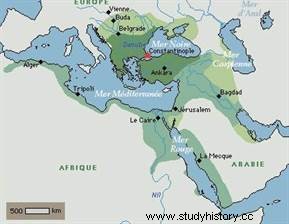 To the internal difficulties is added a loss of economic influence. Since the Portuguese opened a new sea route to Asia bypassing Africa, the Ottoman Empire lost its monopoly on the lucrative trade with the Indies. With the discovery of the Americas, European trade now developed on a global scale. In the midst of the Renaissance, Europe permanently took the upper hand over the Turks in all fields, artistic, economic, military...
To the internal difficulties is added a loss of economic influence. Since the Portuguese opened a new sea route to Asia bypassing Africa, the Ottoman Empire lost its monopoly on the lucrative trade with the Indies. With the discovery of the Americas, European trade now developed on a global scale. In the midst of the Renaissance, Europe permanently took the upper hand over the Turks in all fields, artistic, economic, military...
The first reverses of the Sublime Porte
After taking Podolia from the Poles (1672), the Turks, under the leadership of Kara Mustafa Pasha, resumed the assault on Austria in 1682. For the last time , the armies of the Crescent came to lay siege to Vienna in 1683, but the Polish-German relief army commanded by the Polish king Jean Sobieski crushed the Turks and delivered the city (September 12, 1683).
Allied with Poland and Venice, the Imperials continued their victorious campaign, reconquered Buda (September 1686), defeated the Turks at Mohâcs (August 1687), penetrated deep into Bosnia and Serbia. Prince Eugene won a decisive victory over Moustafa II at Zenta (September 11, 1697), and the Peace of Karlowitz signed on January 26, 1699 restored Hungary (except Banat) and Transylvania to Austria; to Poland, Podolia; in Venice, the Morea and Dalmatia. Mahomet III (1703-1730) nevertheless managed to retake the Morea, but to Turkey's many traditional adversaries had just been added a new enemy, which was not to be the least formidable, Russia.
From then on, the Ottoman Empire had to face the Russian threat. After several wars and the annihilation of the Turkish fleet, the sultans were forced to cede Crimea to Russia and granted it free movement in the Black Sea and the Mediterranean. The interference of the European powers then became constant with the declining empire, under the term "Eastern question".
Decline and dismantling of the Ottoman Empire
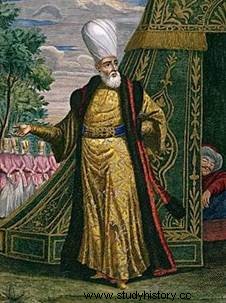 Russia, spiritual heiress of Byzantium, was no longer going to stop trying to make its way to the Straits . Around the decadent empire, agitated by the movements of the minorities, the great powers had to confront each other in the name of contradictory interests. Catherine II, as early as 1783, purely and simply annexed the Crimea, where the powerful fortress and naval base of Sevastopol was built. Russia and Austria began at this time to consult each other with a view to dismembering the Turkish Empire (treaty of 1781 between Catherine II and Joseph II). The 1787-1792 war pitted Turkey against the Russians and the Austrians. Victorious against the latter, the Turks saw themselves inflicted by the Russians a new series of defeats which precipitated the end of the mediocre Sultan Abul-Hamid I (1774-1789).
Russia, spiritual heiress of Byzantium, was no longer going to stop trying to make its way to the Straits . Around the decadent empire, agitated by the movements of the minorities, the great powers had to confront each other in the name of contradictory interests. Catherine II, as early as 1783, purely and simply annexed the Crimea, where the powerful fortress and naval base of Sevastopol was built. Russia and Austria began at this time to consult each other with a view to dismembering the Turkish Empire (treaty of 1781 between Catherine II and Joseph II). The 1787-1792 war pitted Turkey against the Russians and the Austrians. Victorious against the latter, the Turks saw themselves inflicted by the Russians a new series of defeats which precipitated the end of the mediocre Sultan Abul-Hamid I (1774-1789).
In this almost hopeless situation, and as the Ottoman troops fled before the Russians, ascended the throne a young sultan, Selim III (1789-1807). It was he who inaugurated the age of reform in Turkey, an audacity which he had to pay with his life. It was too late to redress the military situation, and at the peace of Iassy (Jan. 9, 1792), Russia had her possession of the Crimea and the Black Sea coast confirmed, and she carried her frontier to the Dniester.
Admirer of French civilization and surrounded by French advisers, Selim III immediately undertook to reorganize his army in the European style), but he was too timid and hesitated to dissolve the Janissaries , who became the most bitter opponents of the reforms. New external and internal perils further weakened the sultan's authority. Bonaparte's expedition to Egypt (1798) was further proof of the casualness with which Europe now treated Turkey.
Even more serious was the Greek War of Independence, because it provoked for the first time the concerted intervention of the great powers in Ottoman affairs. Signed in 1829, the Treaty of Adrianople consecrates Greek independence and Serbian autonomy, grants Russia free navigation at the mouth of the Danube and in the Black Sea. In 1832, the Egyptian army led by Ibrahim Pasha took Palestine and Syria, and besieged Constantinople. The Russians need help to save the city. From now on, the European powers, which seek to satisfy their territorial ambitions at the expense of the Ottoman Empire, will be more pressing in imperial affairs.
While at the end of the Crimean War, the Treaty of Paris (March 30, 1856) preserved Ottoman territorial integrity against Russian appetites, but consecrated the he intervention of the Europeans in 1860 arose from all sides revolts, each of which would contribute to the dismemberment of the Ottoman Empire. The Druze revolt in 1860 and the massacre perpetrated against Maronite Christians in Lebanon provoked the military intervention of France in the country, which came under French domination. In 1875 and 1876, Bosnia, Bulgaria, Serbia and Montenegro also rose up. The bashi-bouzouks (mercenary horsemen of the Ottoman army) having responded with a massacre of Christians, Russia intervened in 1877.
In 1878, Sultan Abdülhamid II (1876-1909) had to accept the Treaty of San Stefano, the terms of which were reviewed at the Congress of Berlin. The European powers decide the fate of the empire:Serbia, Montenegro and Romania become independent. Thessaly and Epirus return to Greece, Bessarabia to Russia, while Austria occupies Bosnia and Herzegovina.
At the same time, the cost of the reforms combined with the loss of revenue from an amputated empire drove the Ottoman state into bankruptcy. The economy of the country is put under Franco-English tutelage. The Sultan, under pressure from the liberals of the “Young Ottomans” movement, agreed in 1876 to endow the State with a Constitution, establishing a system of parliamentary monarchy and enshrining individual and religious freedoms in the fundamental laws. As early as 1878, however, he restored an absolutist government.
The decline continues. After the first massacre of the Armenians, between 1894 and 1896, the Ottoman State was banished from nations. In 1897, the Greeks took Crete, while in Macedonia the terrorism of the comitadjis was rampant. The Persian Gulf came under English control.
Europe's Sick Man
Liberal and nationalist officers, who in 1895 formed the Young Turk movement, in 1908 organized an uprising of troops based in Macedonia which forced the despot to restore the Constitution and the parliament. Bulgaria having proclaimed its independence in 1908 and Austria having annexed Bosnia and Herzegovina in 1909, the army of Thessaloniki, dominated by the Young Turks, marched on Istanbul, deposed Abdülhamid II and brought Mehmet V to power. the power is until 1918 in the hands of the Young Turks, led by Enver Pasha.
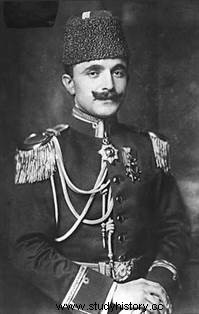 The Ottoman state was continually at war until its end:against Italy first, which took Tripolitania in 1912; then in the Balkans where he must face a coalition formed by Serbia, Montenegro, Bulgaria and Greece (see Balkan wars). In 1913, after the signing of the Treaties of London and Constantinople, the only remaining parts of the empire were Anatolia, Western Thrace and Istanbul in Europe, as well as Hejaz in the Arabian Peninsula.
The Ottoman state was continually at war until its end:against Italy first, which took Tripolitania in 1912; then in the Balkans where he must face a coalition formed by Serbia, Montenegro, Bulgaria and Greece (see Balkan wars). In 1913, after the signing of the Treaties of London and Constantinople, the only remaining parts of the empire were Anatolia, Western Thrace and Istanbul in Europe, as well as Hejaz in the Arabian Peninsula.
The dismantling is completed after the First World War. Enver Pasha has indeed engaged Turkey alongside Germany and Austria-Hungary. In 1916, the United Kingdom favored the Arab revolt against Ottoman domination. Defeated in 1915 in the Dardanelles, the Allies resumed the offensive and forced the Turks to sign the armistice of Mudros in October 1918. The empire was reduced to Anatolia.
In March 1919, Sultan Mehmet V had no choice but to appoint a government close to the victors. Mustafa Kemal (future Atatürk) takes the lead of a nationalist movement. In October 1919, he organized elections and became head of government in April 1920. After the Greek offensive in Anatolia, Mehmet V agreed to sign the Treaty of Sèvres (August 1920), which provided for the cession of the Arab provinces. Mustafa Kemal leads the nationalist counter-offensive against the Greeks, expelled from Anatolia in 1922.
In July 1923, by the Treaty of Lausanne, the Allies recognized the victory of Mustafa Kemal. The Republic of Turkey is proclaimed on October 20, 1923 is proclaimed, of which Mustafa Kemal will become the first leader. The following year, the caliphate, the last remnant of the Ottoman Empire, was abolished.
Bibliography
- History of the Ottoman Empire, by Robert Mantran. Fayard, 2003.
- The Ottoman Empire and Europe, by Jean-François Solnon. Tempus, 2017.
- The Divan of Istanbul:A Brief History of the Ottoman Empire, by Alessandro Barbero. Payot, 2014.
